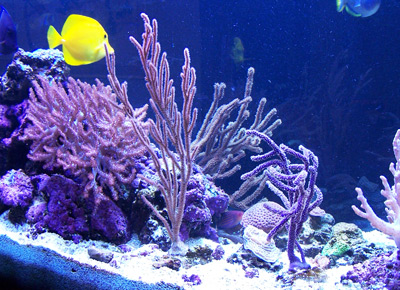I wouldn’t exactly say I have major regrets about choosing a standard 125-gallon tank for my current marine aquarium system, but if I had to do it all over again, I might go in a slightly different—rather, slightly wider—direction. For the benefit of any salties out there who are planning a new setup, I thought I’d share why I think going with a wider tank might have been a better choice.
First I should specify that aquarium dimensions are typically given as length x width x height, with length representing the side-to-side measurement and width representing the front-to-back measurement. This always throws me because to my way of thinking, width should describe an object’s measurement from one side to the other. After all, when I look at my reflection in the mirror, I don’t think to myself, “Wow, my belly sure is getting long!” And there’s a reason ABC’s old sports anthology series wasn’t called The Long World of Sports.
But I digress.
This aquarium—which is 18½ inches wide (counting the trim)—has been operating for the better part of 10 years and functioned as a FOWLR system for most of that time. The tank serves as a room divider, separating the great room in my home into two distinct sitting areas, and is viewable from three sides. I only recently converted it to a reef tank after tearing down my 75-gallon system, which, as I’ve mentioned in prior posts, had become largely overrun with green star polyps and pulsing Xenia.
So why, after nearly 10 years, am I bothered by the width of my 125-gallon? Well, as you can probably guess, it was the conversion from FOWLR to reef system that highlighted its drawbacks. They include:
Cleaning obstructions
The rockwork in this tank is configured in two peaks, with an open channel between, and positioned away from the glass on all sides. One of the reasons I chose this arrangement (in addition to maximizing viewing potential) was so I could easily reach the glass anywhere in the tank for cleaning with an algae magnet, brush, or scraper. However, with the few corals I moved from the 75-gallon growing larger and encroaching on the glass, and having recently adopted several of Caribbean Chris’s inverts, I’m finding that it’s now a little more difficult to clean algae from the glass without bumping into livestock.
Shrinking swimming space
Another reason I aquascaped the tank as I did was so the fish can swim in an unobstructed circular or figure-eight pattern. They can still swim in either of these patterns around the rockwork with the current invertebrate livestock present, but the word “unobstructed” doesn’t exactly apply anymore. They now have to do considerably more maneuvering around or through corals and gorgonians en route.
Restricted invertebrate “elbow room”
Of course, the minimal front-to-back dimension also limits coral placement, and those growing outward from the side of the rockwork, rather than upward from the top, don’t have all that far to go before they hit glass.
Just a few more inches would do it!
Again, I wouldn’t say I’m dissatisfied with my current setup. All in all, I’m very pleased with it. But if I had gone with a slightly larger tank—say, a 180-gallon by the same manufacturer, which would be the same length but would give me 6 more inches of width to work with—I’d probably be better off.
Just something to think about if you’ll soon be in the process of a new tank build. Go wider if you can!



